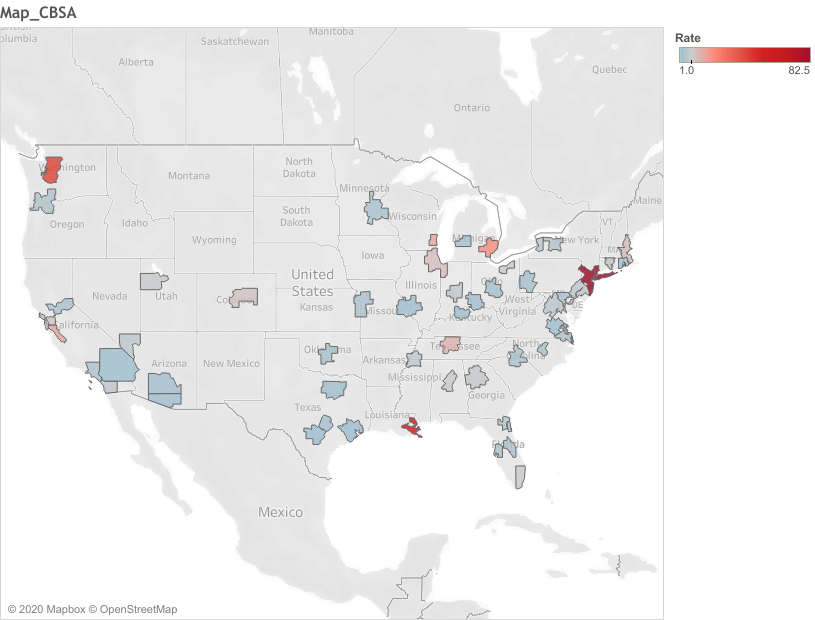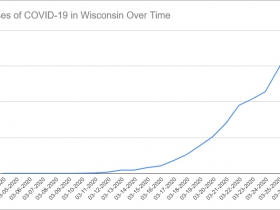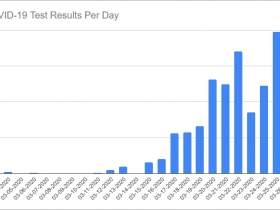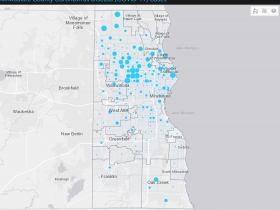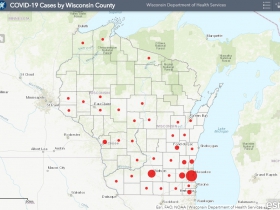Milwaukee Metro Area Ranks 6th Nationally for COVID-19 Case Rate
Four-county area has more cases per 100,000 residents than Chicago and San Francisco.
The Milwaukee metropolitan area has the sixth-highest rate of confirmed COVID-19 cases in the country with 15.2 cases per 100,000 residents.
That’s ahead of cities with high-profile outbreaks like Chicago (10.8) and San Francisco (9.1). Leaders in both of those regions have been more aggressive in limiting public movement and enforcing social distancing. Chicago Mayor Lori Lightfoot closed Lake Michigan beaches and trails this week and six Bay Area counties around San Francisco issued “shelter in place” orders a week ago. Milwaukee Mayor Tom Barrett and Milwaukee County Executive Chris Abele have repeatedly said they hope people voluntarily comply with state orders to social distance and stay home.
The Milwaukee metropolitan area includes suburban communities like Waukesha, West Bend and Mequon as well as Milwaukee. The U.S. Census Bureau-defined metropolitan statistical area is made up of Milwaukee, Waukesha, Ozaukee and Washington counties.
Milwaukee trails only New York City (82.5), New Orleans (54.8), Seattle (41.3) and Detroit (21) and San Jose (15.4) in confirmed case rate as of March 22nd.
Do you live somewhere else? Don’t be lulled into a sense of security. “The typical metro is only about 1-2 weeks behind these cities in the progression of the virus,” warns Cortright.
As with all COVID-19 case data, it’s a rapidly changing dataset. Not only are the number of cases accelerating nationally, but testing capacity varies by region.
The City Observatory report includes an interactive map and chart to explore the outbreak. The lowest rates in any metro areas have been reported in San Antonio, Houston, Riverside and St. Louis. Each had fewer than 1.5 cases per 100,000 residents.
State data current as of March 24th at 9 p.m. shows that Milwaukee County has 290 cases, Waukesha has 42, Ozaukee has 20 and Washington has 21. That would boost the metro area’s case total to 23.9 cases per 100,000 residents (based on 2020 census data), putting the area ahead of where Detroit was on the 22nd.
Milwaukee County was reporting 343 cases as of 6 a.m. on March 26th, including 267 in the City of Milwaukee.
Six deaths have been reported in the Milwaukee-West Allis-Waukesha metro area, including five in Milwaukee County.
Public health officials are strongly encouraging everyone that can to stay home whenever possible and stay at least six feet away from non-household members when they go outside, but they are cautioning that it could be weeks before these practices show results.
Data
All state case data are laboratory-confirmed cases of COVID-19 reported as of 9 p.m. the previous evening.
Charts and Maps
If you think stories like this are important, become a member of Urban Milwaukee and help support real, independent journalism. Plus you get some cool added benefits.
More about the Coronavirus Pandemic
- Governors Tony Evers, JB Pritzker, Tim Walz, and Gretchen Whitmer Issue a Joint Statement Concerning Reports that Donald Trump Gave Russian Dictator Putin American COVID-19 Supplies - Gov. Tony Evers - Oct 11th, 2024
- MHD Release: Milwaukee Health Department Launches COVID-19 Wastewater Testing Dashboard - City of Milwaukee Health Department - Jan 23rd, 2024
- Milwaukee County Announces New Policies Related to COVID-19 Pandemic - David Crowley - May 9th, 2023
- DHS Details End of Emergency COVID-19 Response - Wisconsin Department of Health Services - Apr 26th, 2023
- Milwaukee Health Department Announces Upcoming Changes to COVID-19 Services - City of Milwaukee Health Department - Mar 17th, 2023
- Fitzgerald Applauds Passage of COVID-19 Origin Act - U.S. Rep. Scott Fitzgerald - Mar 10th, 2023
- DHS Expands Free COVID-19 Testing Program - Wisconsin Department of Health Services - Feb 10th, 2023
- MKE County: COVID-19 Hospitalizations Rising - Graham Kilmer - Jan 16th, 2023
- Not Enough Getting Bivalent Booster Shots, State Health Officials Warn - Gaby Vinick - Dec 26th, 2022
- Nearly All Wisconsinites Age 6 Months and Older Now Eligible for Updated COVID-19 Vaccine - Wisconsin Department of Health Services - Dec 15th, 2022
Read more about Coronavirus Pandemic here


